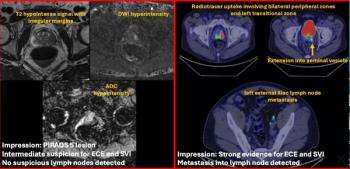
MDIS large-scale PACS also benefits low end
Picture archiving and communication system technology developedby Siemens and Loral Aerospace in their successful bid to supplyPACS to U.S. Army and Air Force hospitals (SCAN 10/9/91) was designedto meet the needs of large-scale PACS installations. There
Picture archiving and communication system technology developedby Siemens and Loral Aerospace in their successful bid to supplyPACS to U.S. Army and Air Force hospitals (SCAN 10/9/91) was designedto meet the needs of large-scale PACS installations. There shouldalso be trickle-down benefits for sub-PACS applications, saidJohn H. Perry, vice president of the computer systems divisionof Siemens Gammasonics.
Loral's technical contribution to the medical diagnostic imagingsupport (MDIS) military bid centered on supply of a powerful centralimage storage and file handling system. The computer technologywas developed as part of Loral's long-standing Air Force contractto supply equipment for transmission and evaluation of air reconnaissancephotos, Perry said.
The Loral storage system can be thought of as a giant, extremelyfast disk drive with storage capacity measured in tens of gigabytesand data distribution capabilities in tens of megabytes per second.The file system that keeps track of individual stored images iscontrolled by a Digital Equipment (DEC) VAX computer, he said.
Technical cooperation between Siemens Medical and Loral ofSan Jose, CA, was abetted by the fact that both companies utilizedDEC and Apple Macintosh computers in their respective industries,Perry said.
"We were both familiar with the same technologies, havingdone the same types of technical development in different markets.We combined their storage system and our workstations and (imaging)modalities to achieve a very powerful (PAC) system," he said.
Siemens used its LiteBox unit as the primary workstation forMDIS. While LiteBox runs on a Macintosh processor, the medicalimaging vendor added its own technology to boost the workstation'scapabilities. Siemens also brought in components from other outsidesuppliers to round out its MDIS image display offering, Perrysaid.
The MDIS PACS can support display consoles with up to eight2000 x 2000-pixel monitors, he said.
Benefits for sub-PACS applications will derive largely fromimprovements in workstations, imaging modality interfaces andnetworking technology. The high-speed MDIS storage system wouldoffer more power and capacity than required for low-end PACS applicationssuch as teleradiology, he said.
"Development of the large-scale MDIS program naturallyled to components that could be applied in the lower end,"Perry said.
More importantly, implementation of MDIS will help tell themedical imaging industry whether or not PACS are valid in large-scalehospital settings, he said.
Despite the technical strides made, a totally digital radiologydepartment remains out of reach. For instance, sensor technologyhas not yet progressed to the point where routine digital mammographyis realistic, he said.
"The substantially--or almost completely--digital hospitalis certainly going to be investigated in depth with these MDISsystems," Perry said.
Newsletter
Stay at the forefront of radiology with the Diagnostic Imaging newsletter, delivering the latest news, clinical insights, and imaging advancements for today’s radiologists.




























